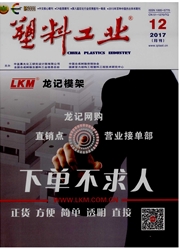

 中文摘要:
中文摘要:
利用多巴胺氧化自聚合可形成一层薄的强黏性复合层的特性,对聚对苯二甲酰对苯二胺(PPTA,对位芳纶)浆粕(AP)表面进行改性修饰,并对改性后的芳纶浆粕进行了X射线光电子能谱、扫描电子显微镜、热失重分析等表征。进一步以丁腈橡胶(NBR)为基体,研究了不同浓度多巴胺浸渍液处理的改性芳纶浆粕及其含量对增强NBR复合材料力学性能的影响。结果表明,聚多巴胺成功附着在AP表面,并在浸渍液质量浓度2.0g/L、浸渍时间24h的实验条件下,改性效果最佳。改性芳纶浆粕的热性能与改性前相比稍有所下降,但仍具有良好的热稳定性能。改性后AP与NBR界面黏结性能有所改善,并显著提高了复合材料的力学性能。
 英文摘要:
英文摘要:
Based on the strong adhesive polydopamine (PDA) films of dopamine (DOPA) oxidative self-polymerization on solid surface, AP were modified via dipping in a DOPA solution at room temperature, and the modified-AP (PDA/AP) were characterized by XPS, SEM and TG. The effects of DOPA concentration and PDA/AP content on the mechanical properties of PDA/AP composites with nitrile rubber (NBR) were investigated. The results confirm that PDA was deposited on the AP surface successfully. Under the reaction conditions of the concentrations at 2.0 g/L for 24 h, the modification effect is the best. The thermal properties of PDA/AP decrease slightly compared with AP, but it is still a promising pulp with good stability. The interface properties between PDA/AP and NBR improve, and the mechanical properties of PDA/AP reinforced NBR composites aldo improve significantly.
 同期刊论文项目
同期刊论文项目
 同项目期刊论文
同项目期刊论文
 期刊信息
期刊信息
